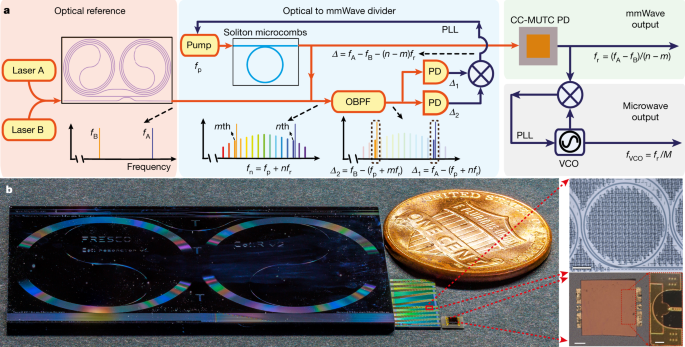Revolutionizing Microwave and mmWave Generation with Integrated Optical Frequency Division
Khái niệm cốt lõi
The author argues that utilizing optical frequency division in miniaturized platforms can significantly enhance communication, radar, and sensing systems by generating ultra-low-noise microwaves and mmWaves with superior spectral purity.
Tóm tắt
The integration of optical frequency division into chip-based platforms presents a transformative opportunity for communication, radar, and sensing systems. By leveraging optical references and frequency combs, this technique offers superior spectral purity compared to other methods. The system demonstrated in the content showcases the potential to transfer this approach to an integrated photonic platform compatible with complementary metal-oxide-semiconductor technology. The phase stability is ensured through a planar-waveguide-based optical reference coil cavity, leading to record-low phase noise for integrated photonic mmWave oscillators. These devices can be seamlessly integrated with semiconductor components like lasers, amplifiers, and photodiodes, paving the way for large-volume, cost-effective manufacturing for various applications.
Integrated optical frequency division for microwave and mmWave generation - Nature
Thống kê
Optical frequency division offers superior spectral purity than other approaches.
Phase stability is provided by a large mode volume planar-waveguide-based optical reference coil cavity.
Soliton microcombs generated in a waveguide-coupled microresonator enable the division from optical to mmWave frequency.
These devices can be heterogeneously integrated with semiconductor lasers, amplifiers, and photodiodes.
Trích dẫn
Thông tin chi tiết chính được chắt lọc từ
by Shuman Sun,B... lúc www.nature.com 03-06-2024
https://www.nature.com/articles/s41586-024-07057-0
Yêu cầu sâu hơn
How might the integration of semiconductor components impact the scalability of these devices
The integration of semiconductor components can significantly impact the scalability of these devices by enabling large-volume, low-cost manufacturing. By heterogeneously integrating semiconductor lasers, amplifiers, and photodiodes with the miniaturized optical frequency division system, it becomes feasible to create compact and efficient systems that are compatible with complementary metal-oxide-semiconductor (CMOS) technology. This integration allows for seamless incorporation into existing fabrication processes used in mass production facilities, leading to enhanced scalability and cost-effectiveness. Moreover, leveraging semiconductor components can facilitate improved performance metrics such as power efficiency and signal quality, further enhancing the overall scalability of these devices.
What are potential challenges or limitations in implementing this technology on a mass-market scale
Despite its promising capabilities, there are several challenges and limitations associated with implementing this technology on a mass-market scale. One significant challenge is ensuring consistent device performance across large-scale production runs due to variations in fabrication processes and material properties. Maintaining high levels of precision and reliability while scaling up manufacturing operations poses another obstacle that needs to be addressed. Additionally, issues related to standardization, regulatory compliance, and market acceptance may arise when transitioning from research prototypes to commercial products for widespread adoption. Furthermore, cost considerations associated with equipment setup, testing procedures, and quality control measures could impede the seamless deployment of these advanced integrated photonic systems on a mass-market scale.
How could advancements in integrated photonic platforms influence future developments in communication systems
Advancements in integrated photonic platforms have the potential to revolutionize future developments in communication systems by offering unprecedented levels of performance efficiency and functionality. The ability to generate ultra-low-noise microwave signals using optical frequency division techniques opens up new possibilities for enhancing communication networks' spectral purity and data transmission rates. By integrating optical references with microresonator-based soliton microcombs on chip-based platforms compatible with CMOS technology, researchers can pave the way for next-generation communication systems characterized by superior phase stability and signal integrity.
These advancements not only enable the creation of compact yet powerful mmWave oscillators but also lay the foundation for incorporating additional functionalities such as modulation schemes or signal processing capabilities directly onto integrated photonic chips. As a result, future communication systems stand to benefit from increased bandwidth capacity, reduced latency times, improved energy efficiency levels—all essential factors driving innovation within telecommunications infrastructure worldwide.
0
